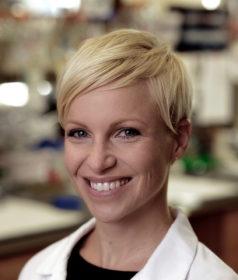Featured Faces of Wake Downtown Full Stories
Dr. Sarah Esstman
Hometown: Dunedin, Florida
Position: Associate Professor of Biology
Research Focus: I am fascinated with viruses! Isn’t everybody right now? I’ve had a long-standing interest in trying to understand how viruses make copies of themselves when they enter inside of our cells. For the last 10 years, my lab has studied rotaviruses, which are important pathogens in humans. Specifically, these viruses cause diarrhea and vomiting in kids, which can be severe and lead to dehydration and even death. Rotavirus infections are mostly controlled by vaccination in the United States and in other developed countries. However, the vaccines aren’t working as well in children living in underdeveloped world regions, and because they are live-virus vaccines, they can’t be used in immunocompromised kids. So, we’re interested in developing new knowledge about rotavirus that could hopefully spur new prevention and treatment measures.
We also think rotavirus is a fantastic model system to understand what viruses do! They’re really simple in their structures, yet really complex in their functions. Rotaviruses share a lot of features with other viruses – even very disparate virus families do some things in common. One facet of my lab focuses on virus replication mechanisms, so we have projects about how the virus makes copies of itself. Another part of my lab involves projects that seek to understand how the replication process leads to genetic diversity, which in turn, allows the virus to evolve.
Our current NIH-funded project is entitled “Mapping Genetic Determinants of Rotavirus Reassortment Restriction”! Rotavirus has a genome that is made up of different segments of RNA, so instead of having just one long RNA molecule, it separates it’s genome into almost like different chromosomes. This genome structure affords the opportunity for the virus to swap segments when it co-infects a cell with other strains. Basically, if two different strains co-infect a cell, one strain will pick up the segment from another strain. Sometimes that segment has an advantage for the virus since it gets a new type of gene and thus a possible new function! Other times it is bad for the virus because it causes a genetic mismatch, such that the proteins and the RNAs don’t work well together during the replication cycle. So because we’re interested in both of these processes of replication and evolution, we’re actually utilizing genetic mismatch (aka reassortment restriction) to try to better understand the protein and RNA interactions of the virus. This is a project that is led by Dr. Emil Nilsson, who is a postdoctoral fellow in my lab, and it involves an undergraduate student, Jacob Thomas. Essentially, Emil is engineering rotaviruses that have different combinations of gene segments with the goal of finding ones that have restrictions. Once he identifies viruses that can’t reassort their gene segments, he will use sequence differences between the ones that can and the ones that can’t to map the restriction sites. So, the question is: what is the sequence that dictates the restriction and is it in the protein or is it in the RNA? We can then perform different biochemical assays to discern what is wrong with a virus such that it can’t replicate.
The other major project that we have going on is related to the process of rotavirus assembly and genome replication. So, rotavirus needs to make copies of this segmented genome, and it does this while it’s assembling new virion particles. It packages the 11 segments into a new particle along with an enzyme called an RNA Dependent RNA Polymerase. This is the enzyme that will actually replicate the genome. For rotavirus, this enzyme is only active when it’s inside of particles. In fact, it’s activity is dictated by a very specific, but not fully understood, interaction with the viral core shell protein. The core shell protein forms the innermost layer of the virion. My senior graduate student, Mackenzie Brown, is focused on mapping which regions and residues of the core shell protein are important for activating the polymerase to initiate genome replication. She performs enzyme biochemistry in the lab to figure this out, but we can also test the importance of these sites in context of the actual virus replication cycle in the future.
What is your favorite thing about being at Wake Forest?
I think that Wake Forest is a very interesting and special place. There aren’t a lot of faculty positions that give you the best of both worlds–allowing you to have an impactful teaching footprint as well as to carry out a really rigorous research enterprise. For example, institutions that are more focused on undergraduate teaching don’t often have the beautiful Wake Downtown research infrastructure and money to support researchers. In contrast, institutions that do have robust research infrastructure typically don’t have a lot of teaching going on. My favorite part about being at Wake is that you can have it all! That teacher-scholar model is true, it’s not just something that they write on paper. The faculty really emulate that.
What is your favorite thing about Wake Downtown and Winston-Salem?
I think that the Wake Downtown facilities are exceptional! I also really like the intellectual environment of Wake Downtown and being connected with faculty who work in similar research areas (such as Biochemistry and Molecular Biology). The downtown area is also really cool! I think that all of the restaurants, breweries, and shops in downtown Winston are neat. And I like the things that go on in Bailey Park too! I like the food trucks and the outdoor yoga and the concerts, I think it’s a really special place, so I’m hoping that once we get past Covid, there will be more events. I definitely miss it!

